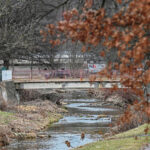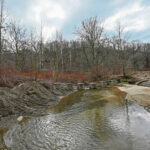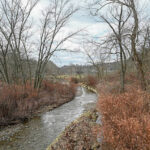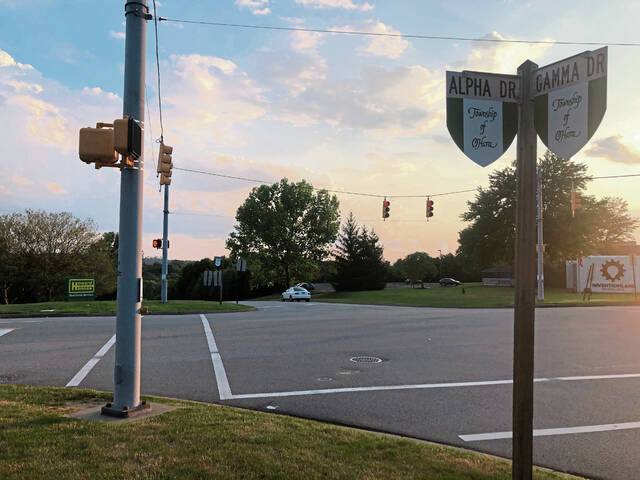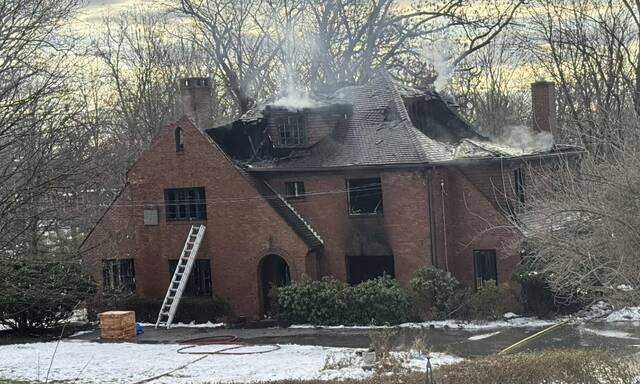Flood control measures installed to protect Valley High School and its campus, including the New Kensington-Arnold School District’s football stadium, are overdue for needed maintenance.
A debris basin at the upper end of the campus is 80% full and “minimally functioning,” said Jim Pillsbury, a hydraulic engineer with the Westmoreland Conservation District.
A dozen V-shaped deflectors in Little Pucketa Creek, made from rocks and intended to help the stream keep itself clean as it flows past the school, also need maintenance, he said.
And while the district is working to replace the twin pedestrian bridges over the creek, it also would be helpful if the district avails itself of the opportunity to remove sediment from the channel, which Pillsbury said there would be less of if the basin had been maintained more regularly.
School board member Bob Pallone and other district officials recently met with Pillsbury about the creek. Pallone, who returned to the board following last year’s election, heads the board’s buildings and grounds committee.
“I wasn’t comfortable that I fully understood what we should be doing versus what we are doing in terms of the creek,” he said. “My past experience on the board tells me that there needs to be a discipline so we keep up on the creek. Because if we don’t, the result manifests itself on our physical plant, whether it’s water in the building or water coming up on the facilities.”
Using state grant money, the debris basin was built after Hurricane Ivan caused the creek to flood the campus in 2004.
“The stream flooded right up to the doors of the school,” said Pillsbury, who has been with the conservation district since 1988. “Water was within inches of going into the building. Water did go into the orchestra pit in the auditorium. You have the risk there of flooding.”
Pillsbury said a study found that sediment and debris would build up in the creek channel in front of the school, obstructing its ability to carry a flood.
The basin — about 230 feet long, 90 feet wide and 4 feet deep — holds about 80,000 cubic feet of volume.
During high water, concrete blocks the size of dishwashers in the creek help direct the water flow into the basin, where it slows down allowing rocks, logs and sand to fall out, Pillsbury said.
“That’s how it’s supposed to work,” Pillsbury said. “In fact, it does work. If you look, the thing is full of rocks.”
The basin has not been maintained for seven or eight years, Pillsbury said.
Because of that, the blocks are jammed with debris, forcing the regular flow of the stream into the basin, causing erosion to the basin and washing debris in the basin back into the stream, Pillsbury said.
The basin should be cleaned every year, and the district is responsible for its maintenance, Pallone said.
He said the district plans to do it this summer.
“It’s been a number of years since it’s been done,” Pallone said. “To be frank, why it wasn’t done isn’t a concern of mine.
“I’m more interested in a process and discipline where we continually have that discipline in place for not just things like cleaning the creek, but for all our necessary preventive maintenance things that need to be done in the district.”
The V-shaped baffles were placed in the stream about the same time the basin was built to deflect the flow to the middle of the channel. The last time he was there, Pillsbury said, he noticed some of the large rocks have been displaced.
The sediment accumulated in front of the school is an issue because it narrows the channel and reduces the volume of water that can be held, Pallone said.
“Its holding volume is what is key. We want it to hold water so it doesn’t go over the banks and into the building,” he said. “When it’s functioning properly, we haven’t seen the stream go up past halfway.”
While the district is permitted to perform maintenance on the basin, it would otherwise need permission to remove sediment from the stream. That was last done 15 or 16 years ago, Pallone said.
The district’s permit for replacing the pedestrian bridges will allow it to clean the stream 50 feet upstream and 50 feet downstream of the bridges, covering a good distance in front of the school, Pillsbury said.
If it turns out to be a bigger project, Pallone said the district will approach state lawmakers in search of grants to pay for the sediment removal.
“It’s one thing to do the work and get all that investment made,” Pallone said. “If you don’t keep on it, it’s going to go back to where we were when we were regularly dismissing kids from school and having water on the facilities.”
“Our paramount goal is to protect the investments in the district and the facilities as a whole,” Pallone said. “Water can be a very destructive force.”





